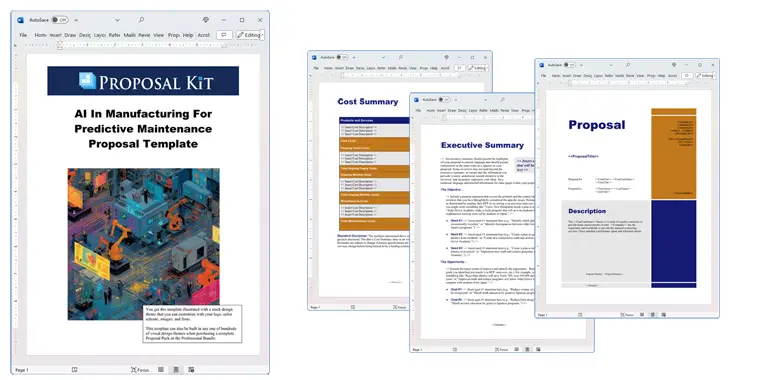How to write your AI In Manufacturing For Predictive Maintenance Proposal Template
We include this 22 page layout with every Proposal Pack. If you want this template to have a different visual design theme than the one illustrated here, purchase any Proposal Pack design and create this template using the purchased design theme. This template is included in every Proposal Pack. If you get a Proposal Pack or the Professional, you can also make any variation of this template with different chapters to suit your needs.
We typically include more chapters in the templates than most people will need to give everyone more variety in the chapters they may need. You can trim down a long template by removing pages you do not need or combining multiple chapter topics into one page.
 DOWNLOADABLE, ONE-TIME COST, NO SUBSCRIPTION FEES
DOWNLOADABLE, ONE-TIME COST, NO SUBSCRIPTION FEESYou can also create countless variations of this document to suit your needs using the included library of 2200+ chapters if ordering a Proposal Pack or Professional.
 What Our Clients Say
What Our Clients SayWe purchased the Proposal Pack today and have already nearly completed what would normally have taken us days of mental anguish to work through. You’ve got a great collection of products and I will not hesitate to recommend your company to colleagues."
Campaign Coalition
Related Article
Related Video
Related Templates
- AI Predictive Maintenance Algorithm Patent Proposal Template
- AI Powered Domestic Manufacturing Proposal Template
- Equipment Maintenance and Repair Services Proposal
- IT Equipment Maintenance and Repair Services Proposal
- Equipment Operation and Maintenance for Water Production Proposal
- Server Upgrade and Maintenance Proposal
- Maintenance Contract Proposal Template
- Technology Strategy Analysis
- Software Beta Testing Project Proposal
- Software System Testing Project Proposal
- Software Automation Proposal
- Software and Hardware System Proposal
- Software as a Service (SAAS) Proposal
- Custom Software Development Proposal
- Defense Contracting Intelligence System Proposal
- Mobile App Software Development Proposal
- Cloud Computing Services Proposal
What's the best way to write your AI in manufacturing for a predictive maintenance proposal?
The most reliable and effective way to create your AI in manufacturing for a predictive maintenance proposal is to use the Proposal Kit template and software package. Proposal Kit provides everything you need to assemble a professional, persuasive proposal quickly and efficiently. With Proposal Kit, you gain access to an extensive library of customizable templates in Word format, a line item quoting database for accurate cost summaries, quotes, and budgets, as well as an integrated AI Writer that generates personalized first drafts tailored to your specific needs in just minutes. You can even convert your finished proposal into a PowerPoint slideshow using the AI-driven PowerPoint generation feature - perfect for client presentations and boardrooms.
If you're facing a project where you need to present a plan for integrating artificial intelligence into manufacturing for predictive maintenance, or you're in a similar situation where efficiency and professionalism matter, Proposal Kit is designed for you. It helps you make your best impression, saves you time, and gives you an advantage to win more contracts and achieve your business goals.
What Types of Projects Are AI In Manufacturing For Predictive Maintenance Proposal Written For?
Proposals for artificial intelligence in manufacturing aimed at predictive maintenance are important when companies want to improve operational efficiency, reduce costly downtime, and ensure the longevity of their equipment. These proposals are tailored for a wide range of manufacturing and industrial situations. Here are examples of project types that often require such proposals:
- Implementing AI-based sensor data analysis for machine failure prediction
- Upgrading legacy equipment with real-time AI monitoring systems
- Automating maintenance scheduling using machine learning algorithms
- Integrating AI with IoT devices for predictive insights
- Developing custom AI dashboards for factory floor managers
- Deploying cloud-based predictive maintenance platforms
- Retrofitting assembly lines with intelligent diagnostics
- Creating automated alerts for early warning of equipment issues
- Improving supply chain reliability with AI-driven maintenance
- Reducing energy consumption through predictive equipment servicing
- Introducing robotic process automation for maintenance tasks
- Designing AI tools for quality control in manufacturing
- Training staff on AI-integrated maintenance systems
- Migrating maintenance operations to centralized AI systems
- Developing mobile apps for real-time predictive maintenance alerts
- Piloting AI-driven maintenance in pilot production lines
- Conducting feasibility studies for AI in predictive maintenance
- Establishing partnerships with AI technology vendors
- Standardizing global maintenance protocols using AI insights
- Evaluating ROI for AI-enabled maintenance investments
Chapters this template is built with
There is no single template that fits every situation. That's why Proposal Kit's software is designed to let you create a custom AI-driven maintenance proposal that meets your exact needs. With thousands of chapter templates available, you can choose and edit the ones suited for your project. Here are some key chapters you might include, each available as a Word format template, and how each serves your proposal
Cover Letter
The Cover Letter is where you introduce yourself and your organization, directly addressing the recipient - such as the plant manager or executive - by name. In an AI in manufacturing for predictive maintenance proposal, you would use this section to briefly explain why the project is important, acknowledge the company's interest in improving equipment reliability, and create a positive, engaging first impression that sets the stage for the rest of your proposal.
Title Page
The Title Page makes your proposal look professional and organized. For this type of proposal, you would include the project's title (for example, "AI-Driven Predictive Maintenance Solution"), your company logo, the client's logo if appropriate, the date, and both parties' contact details. This ensures instant recognition and clarity for anyone reviewing the document.
Table of Contents
A thorough Table of Contents is especially important for technical proposals like this, as it helps readers quickly find sections such as Predictive Analytics, Cost/Benefit Analysis, or Implementation Plan. For an AI in manufacturing for predictive maintenance proposal, this section adds credibility by showing the proposal is well-organized and easy to navigate.
Introduction
In the Introduction, you establish the context of the client's current manufacturing situation - perhaps referencing existing maintenance issues or production downtime - and state how AI integration aims to address these challenges. This section helps everyone understand the proposal's relevance and necessity.
Executive Summary
The Executive Summary gives a succinct overview of your proposal's intent, highlighting how incorporating AI for predictive maintenance will benefit the company. Here, you'd outline the expected results
fewer equipment failures, lower repair costs, and improved productivity, summarizing your key selling points for time-pressed decision-makers.
Goals and Objectives
In this chapter, you clearly specify the measurable goals of your predictive maintenance project. For instance, you might aim to decrease unplanned downtime by 30%, extend machine life by 20%, and optimize maintenance schedules using AI-driven predictions. This clarity ensures all stakeholders understand what success will look like.
Artificial Intelligence
Use this section to explain the specific AI technologies you plan to deploy, such as deep learning models for anomaly detection, machine learning algorithms for trend forecasting, or natural language processing for maintenance logs. This helps the client evaluate your technical approach and innovation.
Predictive Analytics
This chapter delves into the analytics techniques you'll employ, such as sensor data processing, real-time monitoring, and data visualization tools. You would describe how these analytics will help anticipate failures before they happen, enabling proactive rather than reactive maintenance.
Technology
Here you lay out the hardware (sensors, gateways, edge devices) and software (AI platforms, cloud infrastructure, integration APIs) required for your solution. This chapter should detail how the technology fits with the client's existing systems and what upgrades, if any, are necessary.
Maintenance
In this section, you explain both the current maintenance practices and how AI will enhance them. You might outline the shift from calendar-based to condition-based maintenance, or show how predictive alerts will help the client schedule repairs more efficiently and avoid catastrophic failures.
Benefits
This chapter identifies and quantifies the direct and indirect benefits of adopting your solution, such as reducing unexpected breakdowns, lowering spare parts inventory, maximizing equipment uptime, improving safety, and achieving higher overall operational efficiency.
Solutions
Here, you provide a comprehensive description of your AI-powered predictive maintenance solution. This might include workflow diagrams, a list of deliverables, software and hardware integrations, and a timeline from kick-off to deployment, so the client knows exactly what you're offering.
Implementation Plan
The Implementation Plan breaks down the project into actionable steps, with milestones and responsible parties. In a predictive maintenance proposal, you'd include phases like pilot testing, data collection, model training, system integration, staff training, and go-live.
Maintenance Plan
This chapter details how the predictive maintenance system will be monitored and maintained after installation. You'll specify ongoing AI model updates, performance reviews, support schedules, and how you'll handle scaling as the client's needs grow.
Cost Summary
Using Proposal Kit's quoting database, you provide a clear breakdown of all costs - such as equipment, software licenses, integration, support, and training - so the client can see exactly where their investment is going.
Cost/Benefit Analysis
Here you compare the project's total costs to the expected savings and gains. For example, you might show how reducing unplanned downtime will save the company $150,000 per year, or that ROI is expected within 18 months, making your case with clear numbers.
Recommendations
In this section, you leverage your experience to advise the client on the best path forward. You might recommend technology partners, change management practices, or timeline adjustments based on industry best practices and your analysis.
Company History
Demonstrate your reliability by outlining your firm's origins, growth, and previous successes with AI and predictive maintenance projects. This reassures clients you have the experience to deliver results.
Capabilities
Here, you emphasize your company's unique strengths - such as specialized AI expertise, certified data engineers, or proprietary software platforms - that make you the ideal partner for this advanced maintenance project.
References
Share names and contact details of previous clients, along with testimonials or case results from other predictive maintenance installations, to reinforce your track record and earn the client's trust.
Team Members
Introduce the project team, specifying each person's background in AI, data science, maintenance engineering, or project management. This shows the client your team has the skills and expertise required for success.
Back Page
The Back Page offers a final opportunity to leave a professional impression. Include your contact details, company information, legal disclaimers, or a thank-you note, ensuring all communication channels remain open for follow-up.
Use cases for this template
Transforming Unexpected Downtime into Predictable Productivity
The Challenge
At FutureMakers Co., unpredictable machine breakdowns were throwing production schedules into chaos. Every unscheduled stoppage meant missed deadlines, strained client relationships, and profit losses that rippled through the business. Project manager Olivia knew the solution lay in predictive maintenance using AI, but convincing her executive team was no small feat. Decision-makers demanded hard numbers, a clear plan, and a vision that balanced innovation with practical returns. Olivia felt overwhelmed, unsure how to present her ideas in a way that would inspire confidence and commitment.
The Solution
Determined to make her case compelling, Olivia turned to Proposal Kit. The software's AI Writer allowed her to quickly create sections that explained how predictive analytics could eliminate breakdown surprises and how each dollar invested in AI would yield measurable savings. The cost/benefit analysis template made it easy to model different situations and outcomes. By tapping into Proposal Kit's quoting database, Olivia ensured every estimate was backed by real data. She also used visual charts and graphs within the templates to bring her argument to life for even the most numbers-driven executives.
The Implementation
With Proposal Kit's intuitive tools, Olivia tailored a detailed proposal that spoke directly to FutureMakers' needs. She outlined a phased implementation plan, included examples from similar industries, and mapped out key performance indicators to track improvements. The professional layout made her work look polished, while the structure kept her arguments focused and easy to follow. Once the written proposal was finalized, Olivia used the integrated PowerPoint feature to transform her document into a dynamic presentation, complete with visuals and summaries that captured the attention of every executive in the room.
The Outcome
The results were immediate: the executive team was impressed by the clarity, professionalism, and actionable detail in both the written proposal and the supporting PowerPoint. The financial projections and step-by-step rollout plan answered all their questions, and the compelling presentation helped Olivia secure both project approval and the necessary budget. With AI-driven predictive maintenance on the horizon, FutureMakers Co. was finally able to move from reactive scrambles to proactive performance.
Achieving Last-Minute Success on a High-Stakes Retrofit
The Challenge
When a sudden board directive at NovaTech Industries called for a proposal to retrofit the aging assembly line with AI-powered predictive maintenance tools, operations specialist Ethan felt the pressure mount. With just one week to research, write, and present a comprehensive proposal, Ethan worried about missing critical technical details and delivering a document that would stand up to executive scrutiny. The clock was ticking, and the risk of missed opportunity - and reputational damage - was real.
The Solution
Ethan quickly adopted Proposal Kit as his go-to solution. He fed the AI Writer details about NovaTech's unique manufacturing challenges, equipment inventory, and desired outcomes. In minutes, the software generated robust write sections covering all technical and business topics, from the specifics of machine learning integration to the intricacies of ongoing maintenance. Proposal Kit's quoting database allowed Ethan to break down costs line by line, making it easy to compare options and justify expenditures.
The Implementation
With the Proposal Kit's organized framework, Ethan was able to blend AI-generated drafts with his own expert insights, ensuring the proposal was both technically sound and tailored to NovaTech's situation. He filled in the blanks with company-specific data, attached supporting documentation, and used the Maintenance Plan template to demonstrate preparedness for long-term success. The proposal's logical flow and professional formatting meant he never lost track of key points or deadlines. Once complete, he used Proposal Kit's PowerPoint functionality to create a clean, impactful slideshow that summarized the most critical topics for board review.
The Outcome
Ethan's proposal was submitted on time, and his PowerPoint presentation helped make the case clear and compelling in the boardroom. The leadership team appreciated the concise cost breakdowns, implementation roadmap, and visually supported arguments. The project received swift approval, and Ethan's reputation for delivering under pressure was cemented. Thanks to Proposal Kit, NovaTech's retrofit initiative moved forward with confidence, on schedule and on point.
Elevating Non-Profit Operations with a Clear, Competitive RFP
The Challenge
GreenPath Foundation, a nonprofit focused on food distribution, was plagued by frequent equipment failures in its main processing facility. As the facilities director, Mia knew these breakdowns jeopardized food safety and timely deliveries to the community. She needed outside expertise for an AI-driven predictive maintenance solution, but struggled to write an RFP that clearly outlined the nonprofit's unique priorities - tight budgets, regulatory compliance, and the need for partner alignment with their mission.
The Solution
Mia discovered Proposal Kit's RFP templates, which guided her through every step of the process. With the help of Proposal Kit's AI Writer, she described GreenPath's operational goals, the specific technical requirements for AI integration, and the evaluation criteria for vendor selection - all in accessible, jargon-free language. The templates prompted her to consider details such as reporting standards, ethical sourcing, and grant compliance, ensuring nothing was overlooked.
The Implementation
By customizing Proposal Kit's templates, Mia created an RFP that was both thorough and tailored to a nonprofit's needs. She included a maintenance plan that accounted for training and ongoing support, as well as a cost/benefit analysis that factored in both financial and social impact. The organized, visually appealing format made her document stand out. Before issuance, Mia used the PowerPoint creation tool to develop an executive summary slideshow, which she shared with her board to secure buy-in and align on evaluation priorities.
The Outcome
The robust RFP drew responses from several reputable technology providers, each able to understand and address GreenPath's unique requirements thanks to Mia's clear documentation. The board praised her structured approach and the professional PowerPoint summary she presented, which helped streamline the decision-making process. Within weeks, GreenPath Foundation selected the right partner for their AI predictive maintenance upgrade, setting the stage for more reliable facilities and greater impact on the communities they serve.
Conclusions and Recommendations
In summary, when faced with writing an AI in manufacturing for a predictive maintenance proposal - whether you're pitching a new solution, responding to an RFP, or seeking internal funding - using Proposal Kit offers a proven, efficient pathway to success. The software's professional templates, quoting database, AI Writer, and PowerPoint integration empower you to deliver a clear, persuasive, and visually appealing proposal. With the Proposal Kit, you can communicate the value of AI integration, break down complex technology, and win buy-in from key decision-makers. For anyone seeking to streamline proposal creation and make a case for AI-powered predictive maintenance in manufacturing, Proposal Kit is the solution.
Also Known As
This template may also be referred to in different ways or be used in more specialized situations, such as:
- AI maintenance proposal for manufacturing
- Predictive maintenance with an artificial intelligence plan
- Manufacturing equipment AI integration proposal
- Smart factory predictive maintenance solution
- Machine learning maintenance proposal
- Industrial AI for equipment reliability proposal
- AI-powered downtime reduction proposal
- Automated maintenance strategy with AI
- Intelligent maintenance proposal for factories
- Proposal for AI-driven manufacturing systems
Abstract
 AI-driven predictive maintenance in manufacturing transforms maintenance strategies using advanced analytics, real-time sensor data, and historical data to anticipate failures before they occur. Unlike reactive maintenance, predictive maintenance manufacturing uses operational data, equipment parameters, and automated insights to detect anomalies, identify patterns, and forecast maintenance needs, minimizing unnecessary downtime and production delays. Maintenance teams gain the ability to monitor machine health and equipment health through continuous analysis of raw data from IoT sensors and sensor readings, enabling a proactive approach that extends equipment lifespan and reduces maintenance costs. By implementing AI predictive maintenance, manufacturers can optimize preventive maintenance schedules, avoid unnecessary maintenance, and reduce emergency repairs, leading to higher asset uptime, increased energy efficiency, and improved production processes.
AI-driven predictive maintenance in manufacturing transforms maintenance strategies using advanced analytics, real-time sensor data, and historical data to anticipate failures before they occur. Unlike reactive maintenance, predictive maintenance manufacturing uses operational data, equipment parameters, and automated insights to detect anomalies, identify patterns, and forecast maintenance needs, minimizing unnecessary downtime and production delays. Maintenance teams gain the ability to monitor machine health and equipment health through continuous analysis of raw data from IoT sensors and sensor readings, enabling a proactive approach that extends equipment lifespan and reduces maintenance costs. By implementing AI predictive maintenance, manufacturers can optimize preventive maintenance schedules, avoid unnecessary maintenance, and reduce emergency repairs, leading to higher asset uptime, increased energy efficiency, and improved production processes.
Such systems often deploy predictive models and advanced algorithms - including unsupervised learning and edge computing - to analyze usage patterns, operator notes, and massive volumes of real-time data collected from physical equipment on the shop floor. The result is actionable insights and automated reporting that support informed decisions and immediate alerts when early signs of failure are detected. Centralized platforms and cloud analytics further enable manufacturers to expand their maintenance operations, integrate digital twins, and benefit from data-driven insights and prediction accuracy.
Through cost-effective AI applications, manufacturers can explore future trends, improve decision support, and ensure the availability of critical assets and components such as rotating parts. Real-world examples show that analyzing historical patterns and integrating advanced AI tools can help reduce costs, maximize production efficiency, and minimize unnecessary intervention, making predictive maintenance an important strategy for modern manufacturing operations.
 Comprehensive proposals for AI-powered predictive maintenance must clearly outline the business benefits, technology stack, maintenance plans, and implementation strategies, while providing accurate cost summaries and demonstrating how these advanced solutions can transform maintenance from reactive firefighting to proactive performance. With tools designed for complex document assembly, automated quoting, and extensive template libraries, manufacturers can efficiently present their plans for AI-driven maintenance to stakeholders, ensuring that their proposals are persuasive, professional, and tailored to the unique demands of industrial environments.
Comprehensive proposals for AI-powered predictive maintenance must clearly outline the business benefits, technology stack, maintenance plans, and implementation strategies, while providing accurate cost summaries and demonstrating how these advanced solutions can transform maintenance from reactive firefighting to proactive performance. With tools designed for complex document assembly, automated quoting, and extensive template libraries, manufacturers can efficiently present their plans for AI-driven maintenance to stakeholders, ensuring that their proposals are persuasive, professional, and tailored to the unique demands of industrial environments.
Implementing AI predictive maintenance is increasingly crucial for manufacturers who rely on complex machinery and physical equipment across multiple sites. Maintenance teams benefit greatly from such systems, as centralized platforms make it easier to coordinate tasks, share data, and ensure consistency across operations. With real-time analysis of parameters like temperature and equipment performance, maintenance teams can respond to anomalies before failures occur, minimizing downtime and safeguarding production schedules. Unlike reactive maintenance, which leads to costly disruptions and emergency repairs, predictive maintenance enables a more controlled and efficient approach to asset management.
AI applications in this space are designed to handle massive volumes of operational data, using advanced analytics for analyzing patterns and trends that would be impossible to detect manually. This helps organizations to make proactive decisions that improve overall equipment reliability and lifespan. Real-world example situations demonstrate how AI-driven maintenance strategies can reduce both scheduled and unscheduled downtime, helping businesses maintain a competitive advantage in fast-paced markets.
 For organizations preparing a proposal to introduce such innovations, the Proposal Kit streamlines the process. By allowing users to assemble comprehensive documents - complete with automated cost breakdowns, customizable content, and professional formatting - Proposal Kit ensures proposals clearly communicate the value of AI predictive maintenance. This is especially important when presenting to decision-makers who may not be familiar with the technical details but need to understand the high-level business benefits. In the next section, organizations can further detail specific use cases, success stories, or projections to reinforce the case for investment in AI-powered predictive maintenance, moving manufacturing operations toward greater efficiency and resilience.
For organizations preparing a proposal to introduce such innovations, the Proposal Kit streamlines the process. By allowing users to assemble comprehensive documents - complete with automated cost breakdowns, customizable content, and professional formatting - Proposal Kit ensures proposals clearly communicate the value of AI predictive maintenance. This is especially important when presenting to decision-makers who may not be familiar with the technical details but need to understand the high-level business benefits. In the next section, organizations can further detail specific use cases, success stories, or projections to reinforce the case for investment in AI-powered predictive maintenance, moving manufacturing operations toward greater efficiency and resilience.
Implementing AI predictive maintenance marks a transformative shift for manufacturing organizations seeking to stay competitive and resilient. Unlike reactive maintenance, which often results in unexpected production halts and urgent repairs, predictive maintenance, powered by advanced AI applications, minimizes downtime by predicting when failures are likely to happen and enabling timely interventions. This approach ensures that resources are allocated more efficiently and that costly disruptions are avoided.
A real-world example of this strategy in action might involve a manufacturer integrating AI systems with their existing machinery to continuously monitor performance data. By doing so, the company can detect subtle changes in vibration or temperature that precede a breakdown, allowing maintenance teams to address issues before they escalate. In these situations, AI applications not only provide immediate operational benefits but also empower organizations with deeper, long-term insights into equipment usage and reliability trends.
 For those responsible for pitching or leading such implementation efforts, a well-structured proposal is important. Using specialized tools ensures these proposals clearly articulate the advantages of implementing AI predictive maintenance and how it stands apart from traditional methods, providing tangible examples and cost justifications. As adoption of AI applications continues across the manufacturing sector, sharing real-world examples and best practices becomes even more important for demonstrating value to stakeholders and driving broader industry acceptance.
For those responsible for pitching or leading such implementation efforts, a well-structured proposal is important. Using specialized tools ensures these proposals clearly articulate the advantages of implementing AI predictive maintenance and how it stands apart from traditional methods, providing tangible examples and cost justifications. As adoption of AI applications continues across the manufacturing sector, sharing real-world examples and best practices becomes even more important for demonstrating value to stakeholders and driving broader industry acceptance.
Frequently Asked Questions
What main sections should be included in an AI in manufacturing for a predictive maintenance proposal?
When writing an AI in manufacturing for a predictive maintenance proposal, you should include sections that clearly communicate your understanding of the client's needs and your technical solution. Begin with an introduction and executive summary, followed by a detailed explanation of the artificial intelligence technologies you plan to use, your predictive analytics methodology, and the specific maintenance challenges you intend to address. Include an implementation plan, cost summary, cost/benefit analysis, and clear descriptions of your team's qualifications and track record. Adding references and a maintenance plan will help demonstrate your expertise and reliability to stakeholders.
How do I demonstrate the value of AI for predictive maintenance in my manufacturing proposal?
In your AI in manufacturing for predictive maintenance proposal, it's important to quantify potential benefits with real-world data and examples. Use predictive maintenance case studies, cite reductions in downtime, and estimate cost savings based on industry benchmarks or your past projects. Visual aids, such as charts or ROI calculations, can illustrate the improvements in efficiency, reliability, and safety that AI integration can bring to manufacturing processes. This approach helps decision-makers see the tangible value your solution provides.
What financial information should I include in my AI in manufacturing for a predictive maintenance proposal?
For your AI in manufacturing for predictive maintenance proposal, make sure to provide a detailed cost summary, including line-item budgets for software, sensors, integration, and training. You should also include a cost/benefit analysis to highlight the anticipated return on investment, showing how reduced downtime, fewer repairs, and better resource allocation will outweigh the initial costs. Providing clear and well-organized financial data builds trust and confidence in your proposal.
How technical should my AI in manufacturing for a predictive maintenance proposal be?
The technical depth of your AI in manufacturing for predictive maintenance proposal should match your audience's knowledge level. For executive audiences, focus on high-level benefits, business value, and implementation steps. For engineering or IT reviewers, include detailed descriptions of your AI algorithms, data sources, system integration, and performance metrics. Proposal Kit templates allow you to tailor each section so you can provide as much or as little technical detail as your recipient requires.
Can the Proposal Kit help me present my AI in manufacturing for a predictive maintenance proposal in multiple formats?
Absolutely. With the Proposal Kit, you can create a comprehensive AI in manufacturing for a predictive maintenance proposal in Word format, and then seamlessly convert it into a PowerPoint presentation using the software's integrated tools. This feature is especially useful for presenting your proposal in meetings, pitches, or executive briefings, ensuring your message is clear, persuasive, and visually engaging.
20% Off Discount
![]() Add To Cart This Word Template
Add To Cart This Word Template
 Add To Cart Proposal Pack for Any Business
Add To Cart Proposal Pack for Any Business
 Add To Cart Proposal Kit Professional
Add To Cart Proposal Kit Professional
 4.7 stars, based on 849 reviews
4.7 stars, based on 849 reviewsProposal Kit chapters used in this template
Cover Letter, Title Page, Table of Contents, Introduction, Executive Summary, Goals and Objectives, Artificial Intelligence, Predictive Analytics, Technology, Maintenance, Benefits, Solutions, Implementation Plan, Maintenance Plan, Cost Summary, Cost/Benefit Analysis, Recommendations, Company History, Capabilities, References, Team Members, Back Page
Line Item Automated Chapters
If you purchase a Proposal Pack or the Professional Bundle, these proposal pages are generated using an automated line-item database in the included Wizard software.
Cost Summary, Implementation Plan, Cost Benefit Analysis
You use this proposal for
- General business proposal
- Technical proposal
- Project pitch proposal
- IT, software, hardware proposal
- Manufacturing, engineering, fabrication proposal
How to create this template with Proposal Pack Wizard
You can create this document using any of the logo-designed Proposal Packs. Pick any Proposal Pack with a logo design theme you like best; they will all work equally well. The Proposal Pack for Any Business is the pack with no extra added logos or colors - designed to be used plain or for you to customize with your logos and graphics.
The Proposal Pack design theme you purchase will determine the visual look of this template. The screenshot above only shows the plain generic design theme.
We include a library of chapters to be assembled based on your needs. All proposals are different and have different needs and goals. We designed Proposal Pack so you can customize the documents to suit your needs.
You will best create this document using the Proposal Pack Wizard - Expert Edition software to select this template and build it in the Proposal Pack logo design theme of your choice along with any desired customizations (such as adding additional chapters, removing unneeded chapters, changing the order of chapters, and importing your company logo). This template outlines a proposal for the described situation. Each user is responsible for typing in the actual content of the provided pages with their information to complete the proposal. Suggestions in the abstract may include features in higher-end packages and are facilitated by the selection of chapter templates to support the narrative of each proposal, which help guide the user in filling in the details.
The Wizard software's AI Writer will write the content of the pages of the template based on details provided for your company, client, project, financial details and other writing instructions. This will provide a personalized version of the template completely written and ready to edit.
Once finished, the AI Writer's Word-to-PowerPoint converter can transform your proposal, business plan, or other business documents into a PowerPoint slideshow. Save time and effort by letting the AI analyze every chapter to condense its content into talking points, visually matching the document, and providing a consistent package of presentation material with the click of a button.
You create this template using the Wizard software with an entire Proposal Pack library and software. We include the Expert Edition of the software in the Proposal Kit Professional. Microsoft Word for Windows is required to use the customizing software. You can also edit Word document templates in other office software such as Word for Mac. We will assist Mac users in assembling complex templates for their first project if they do not have the required platform to run the Wizard software.
How to Build Templates Featured on Proposal Kit Website
Many people find the Proposal Kit website after searching for a specific proposal. Once you've purchased and installed the software, how do you build that template you found in the first place? This video shows you how to build any proposal you see on the Proposal Kit website.
 Ian Lauder has been helping businesses write their proposals and contracts for two decades. Ian is the owner and founder of Proposal Kit, one of the original sources of business proposal and contract software products started in 1997.
Ian Lauder has been helping businesses write their proposals and contracts for two decades. Ian is the owner and founder of Proposal Kit, one of the original sources of business proposal and contract software products started in 1997.By Ian Lauder
 Published by Proposal Kit, Inc.
Published by Proposal Kit, Inc.


 Cart
Cart
 Get 20% off ordering today:
Get 20% off ordering today: 


 Facebook
Facebook YouTube
YouTube Bluesky
Bluesky Search Site
Search Site